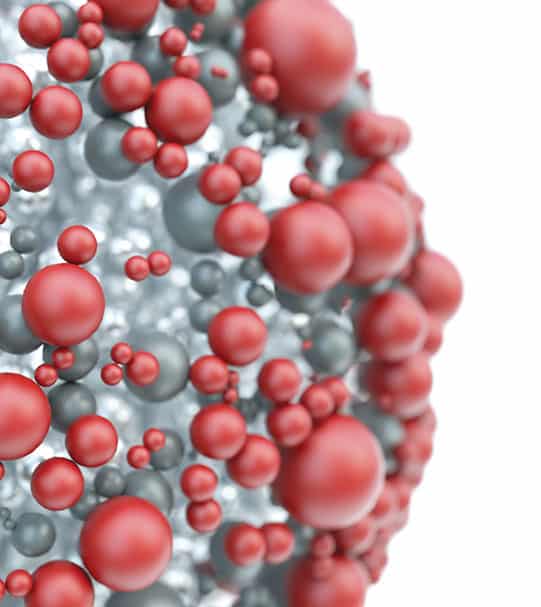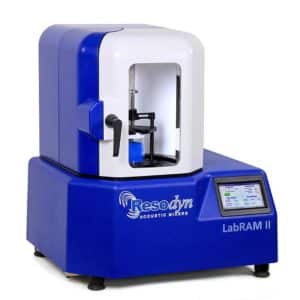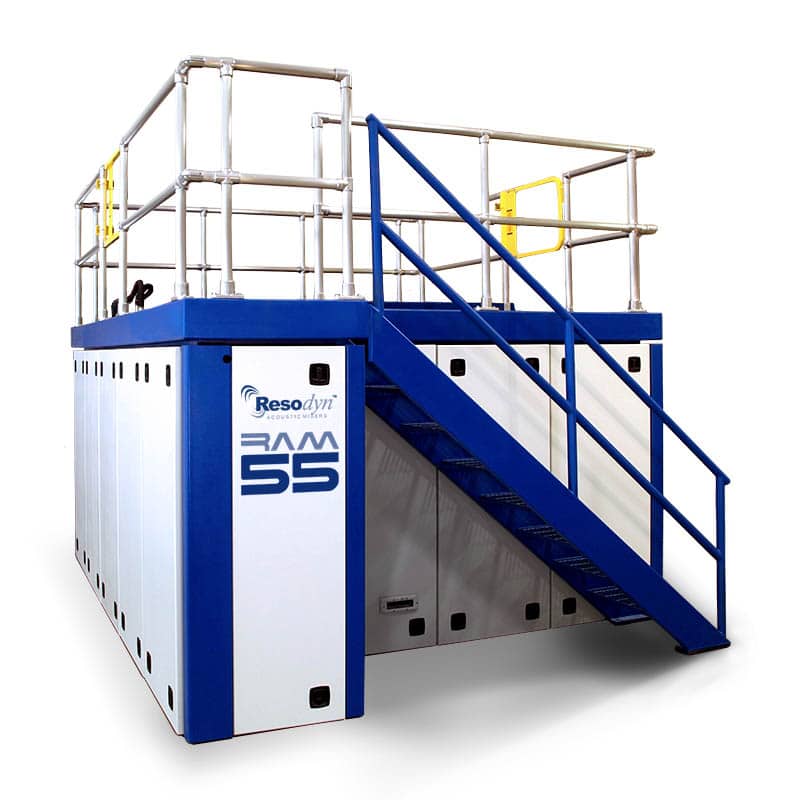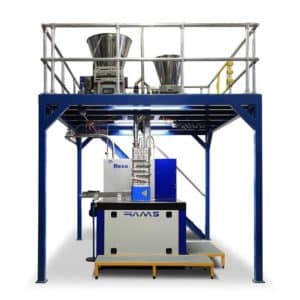

Home » Industries Served » ResonantAcoustic Mixers for Specialty Materials Processing | Cosmetics | Nanomaterials | Pigments | Synthetic Polymers
THE SPECIALTY MATERIALS PROCESSING
TECHNOLOGY OF CHOICE
Ours is no ordinary mixer. It's the only one of it's kind. Providing a standardized platform for material processing development, Resodyn Acoustic Mixers, Inc. provides a complete range of mixing equipment geared toward advanced specialty material manufacturing companies.
ResonantAcoustic® Mixing technology is unique to the specialty material mixing industry. Its advanced processes have opened the door to a vast array of exciting innovations and diverse industry applications.
ResonantAcoustic® Mixing provides a uniquely scalable stage for technological development.
This low frequency (60 Hz) mixing system provides unparalleled consistency in performance and repeatability from which to base the advancement of material processing. ResonantAcoustic® Mixing (RAM) technology has been the preferred embodiment for the invention of a multitude of Patent Applications. RAM is simply the “best mode known” for consistent lab scale, bench scale and commercial scale development of mixing innovations.
RAM enabled advancements include but are not limited to:
- Cosmetics
- Dental Products
- Elastomers
- Electronics Materials
- Graphene Inks
- Lubricants
- Medical Devices
- Nanomaterials
- Pigments
- Sintered Materials
- Super Abrasives
- Synthetic Polymers
- Technical Ceramics

INDUSTRY EXPERT
TESTIMONIALS
“... [ResonantAcoustic® mixing] is a fantastic technology. It has revolutionized the way we mix for development of materials for additive manufacturing...”
- Nik Ninos, Research and Development Manager, Calix Ceramic Solutions
“Resonant acoustic mixers from Resodyn have proven to be extremely valuable in graphene development for our clients. It is critical for nanotechnologies such as graphene to be processed with the level of exacting consistency and particle distribution, especially at low loadings, that RAM has proven to consistently achieve.”
- Research Scientist, European Nanomaterial Research Organization
“[We] mix different rheologies with powder metals, highly viscous, and the LabRAM II has proven it can do that effectively. We’re very impressed with the build quality of the mixer--it’s a nice, solid, well-thought-out piece of equipment. It’s done very well for us.”
- Managing Engineer, Major U.S. Research Laboratory
THE UNIVERSAL
MIXING SOLUTION
The ResonantAcoustic® Mixer (RAM) product line harnesses the power of resonance (low-frequency sound) to generate powerful and efficient mixing of complex Solid-Solid, Solid-Liquid, Liquid-Gas, and Liquid-Liquid Blends. Benefits include;
- 10-100X faster mixing times
- bladeless non-contact mixing
- consistent homogenization
- repeatable
- scalable
- durable
- custom engineered systems
- reliable
- cost saving
- eco-friendly operation
- unmatched safety
Videos
Client Testimonial - Hyaluronic Acid Crosslinking in as little as 1 minute with ResonantAcoustic Mixing!
ResonantAcoustic® Mixing (RAM) for Innovation in Cosmetics and Pharmaceuticals.
Successful application of ResonantAcoustic® Mixing (RAM) technology to Hyaluronic Acid (HA) crosslinking leads to significant technological advantages and at the same time allows crosslinked HA gels.
Client Testimonial - NASA Invents GRX-810 SuperAlloy with RAM!
NASA recently invented a new high temperature 3D-Printed GRX-810 superalloy with almost double the tensile strength, more than double the ductility, and orders of magnitude (10X-2000X) better creep rupture life than conventional superalloys and current 3D-printable metal parts.
GRX-810 cannot be produced by conventional machining, and is 3D-printed. GRX-810 can be used in space launch systems, heat exchangers in nuclear power plants and other extreme temperature environments, thanks to RAM technology.
GRX-810 is made by coating NiCoCr metal powder with a film of nanoscale Y2O3 oxide particles using RAM technology.
Prior attempts to mechanically alloy the Y2O3 onto the metal powder with traditional equipment had deformed the powder. It became more platelet-like, had a tendency to stick, and as a result was much more difficult to print.
RAM rapidly and powerfully, yet gently coats the metal powder with the ceramic, without deforming the powder. The powder remains very spherical and flows well through the 3D printer.
Dissimilar Powder Mixing in 10 Seconds!
Dry ingredients can be difficult to thoroughly and consistently mix, particularly when the particles are of different sizes and characteristics. To illustrate effective and rapid mixing, 10 grams of fumed silica is blended with 100 grams of sand in 10 seconds! Completed specimens exhibit no airborne fumed silica, demonstrating uniform blending at an order of magnitude difference in particle size.
Milling and Nano Coating in 8 Seconds!
Coating larger particles with smaller ones is a common processing application, and milling is often a part of the same process. In this video, agglomerated carbon black particles are simultaneously milled to nano size particles that coat the plastic pellets completely in just a few seconds. The high speed video clearly illustrates the dispersion of carbon black particles, their de-agglomeration, and progressive and comprehensive coating of the plastic pellets.
Powder Incorporation in Viscous Liquid in 8 Seconds!
Many polymer-based materials require the addition of dry or powder materials for specific performance characteristics or coloration. To illustrate dry powder incorporation in a viscous liquid, a small amount of dry ingredient is rapidly blended with a viscous liquid. The newly captured mixing phenomena reveal how the thoroughly blended and uniform mixture is achieved in a very short mixing time.
Loaded Polymer Blending in Less than 3 Minutes!
To illustrate a heavily loaded polymer blend, two materials of very different particle sizes are blended with a polymer surrogate. This footage documents the nature of the material blending and integration into a heavily loaded (~85%) polymer based paste in just over 2 minutes! The use of RAM™ technology is ideally suited for loading of solids into polymers and mixing to a high rate of dispersion and consistent viscosity throughout the blend.
Articles
Preparation of thiol-decorated Ag nanoparticles on N-doped carbon through resonant acoustic mixing for electrochemical CO2 reduction
Catalysis Today
However, the practical production of these supported metal NPs necessitates a facile and scalable approach. Addressing this challenge, the present study introduces a novel method for solid-state synthesis of Ag/C using resonant acoustic mixing (RAM). The RAM technique successfully facilitated the deposition of Ag nanoparticles onto n-doped carbon support, forming Ag/N-C catalysts.
Hyun, J., Cho, M., Lee, J., Kim, T., & Pak, C. (2023). Preparation of thiol-decorated Ag nanoparticles on N-doped carbon through resonant acoustic mixing for electrochemical CO2 reduction. Catalysis Today, 426, 114368. https://doi.org/10.1016/j.cattod.2023.114368
Extreme Temperature Additively Manufactured GRX-810 Alloy Development and Hot-fire Testing for Liquid Rocket Engines
AIAA SCITECH 2022 Forum
… coated with sub 100nm Y2O3 particles using the resonant acoustic mixing process [16]. Lot 2 … In fact, there appears to be a slightly higher frequency of oxides nanoparticles in the Lot 2 …
Gradl, P. R., Smith, T. M., Tinker, D. C., Williams, B., & Kantzos, C. (2024). Extreme temperature additively manufactured GRX-810 alloy development and hot-fire testing for liquid rocket engines. AIAA SCITECH 2022 Forum. https://doi.org/10.2514/6.2024-0997
A new ternary high-energy composite based on nano titanium powder with low sensitivity and stable combustion
Combustion and Flame
For solving the low combustion efficiency caused by aggregation and further promoting the application of nano titanium powder (n-Ti), a new ternary composite high-substitute nitrochitosan/nano titanium/graphene oxide (NCh/n-Ti/GO) was prepared by a resonant acoustic mixing method.
Wan, C., Guo, Z., Zhang, W., Chen, S., Qin, Z., & Xu, K. (2022b). A new ternary high-energy composite based on nano titanium powder with low sensitivity and stable combustion. Combustion and Flame, 247, 112480. https://doi.org/10.1016/j.combustflame.2022.112480
Tailoring Vibrational Signature and Functionality of 2D-Ordered Linear-Chain Carbon-Based Nanocarriers for Predictive Performance Enhancement of High-End Energetic Materials
Nanomaterials
The technological chain of the transformative energetic materials (TEM) preprocessing and synthesis includes the following main stages... the resonant acoustic mixing (RAM) of the EM composition, leading to changes in the material properties
Lukin, A., & Gülseren, O. (2022). Tailoring vibrational signature and functionality of 2D-Ordered Linear-Chain Carbon-Based nanocarriers for predictive performance enhancement of High-End energetic materials. Nanomaterials, 12(7), 1041. https://doi.org/10.3390/nano12071041
Resonant Acoustic Mixing Method to Produce Lipid-Based Liquid-Crystal Nanoparticles
The Journal of Physical Chemistry C
We have found that when compared to traditional sonication-based methods, the use of resonant acoustic mixing allows for large-scale synthesis of nanoparticle solutions and the formation of LLC nanoparticles of desirable sizes.
Yalcin, D., Rajesh, S., White, J., Howard, S. C., Pigram, P. J., Tran, N., & Muir, B. W. (2021). Resonant acoustic mixing method to produce Lipid-Based Liquid-Crystal nanoparticles. The Journal of Physical Chemistry C, 125(19), 10653–10664. https://doi.org/10.1021/acs.jpcc.1c01300
3D-printed nanoporous ceramics: Tunable feedstock for direct ink write and projection microstereolithography
Materials & Design
The [ceramic additive manufacturing] ink was mixed with spherical zirconia grinding beads (4 mm diameter) in a LabRAM II acoustic mixer for 3 h at 70 g-force to break up agglomerates and disperse the particles. The LabRAM II mixing time was determined by SEM images of the inks at different time points to ensure homogeneous dispersion...
Troksa, A. L., Eshelman, H. V., Chandrasekaran, S., Rodriguez, N., Ruelas, S., Duoss, E. B., Kelly, J. P., Cerón, M. R., & Campbell, P. G. (2020b). 3D-printed nanoporous ceramics: Tunable feedstock for direct ink write and projection microstereolithography. Materials & Design, 198, 109337. https://doi.org/10.1016/j.matdes.2020.109337
Investigation of the impact of particle size on properties and applications of a ceramic slurry
To make the ceramic slurry, 3YZrO2 nanoparticles were mixed with polyethylene glycol diacrylate (PEGDA Mn 575, Sigma Aldrich) and zirconia grinding media and mixed for 3 hours in a Resodyn™ LabRAM II acoustic mixer.
Eshelman, H. V. (2019). Investigation of the impact of particle size on properties and applications of a ceramic slurry. https://doi.org/10.2172/1526159
Investigating high energy mixing in cement-based materials
Digital Commons @ UConn
RAM mixing does not use a tool [e.g., impeller] that directly interacts with the mixing medium. This makes it an attractive mixing device as it reduces the cost of wear and tear of the mixing device...A 30% increase in 3-day and 20% increase in 28-day mechanical properties were observed in UHPC specimens mixed with RAM. The improved mechanical properties support there is more uniform mixing energy transmitted to the system during mixing which enhances cement hydration and reduces air voids.
Vandenberg, A. (n.d.). Investigating high energy mixing in cement-based materials. Digital Commons @ UConn. https://digitalcommons.lib.uconn.edu/dissertations/2030/
Final Report on Creation of Energetic Materials Laboratory, Univ. of Texas El Paso
Defense Technical Information Center
The objective of this project was to acquire equipment and instrumentation for research and education on energetic materials that would enhance the University’s capabilities in materials preparation, materials characterization,
and combustion experiments...The [Resodyn Acoustic Mixers LabRAM] will enhance the academic experience for students and help prepare them for productive work in advanced areas of engineering important for the U.S. Department of Defense.
Defense Technical Information Center. (n.d.). https://apps.dtic.mil/sti/citations/ADA625519
A new and improved method for the preparation of drug nanosuspension formulations using acoustic mixing technology
International Journal of Pharmaceutics
[We used] low shear acoustic mixing to rapidly identify optimized nanosuspension formulations for a wide range of compounds with dramatically improved material and time efficiencies.
Leung, D. H., Lamberto, D. J., Liu, L., Kwong, E., Nelson, T., Rhodes, T., & Bak, A. (2014c). A new and improved method for the preparation of drug nanosuspension formulations using acoustic mixing technology. International Journal of Pharmaceutics, 473(1–2), 10–19. https://doi.org/10.1016/j.ijpharm.2014.05.003
Preparation and Characterization of Aqueous Nanothermite Inks for Direct Deposition on SCB Initiators
Propellants Explosives Pyrotechnics
...[RAM] uses an environmentally friendly mixing medium, can result in a higher density final material, and allows safe one-step mixing and deposition.
Nellums, R. R., Son, S. F., & Groven, L. J. (2014). Preparation and characterization of aqueous nanothermite inks for direct deposition on SCB initiators. Propellants Explosives Pyrotechnics, 39(3), 463–470. https://doi.org/10.1002/prep.201400013
Nano-Aluminum Thermite Formulations: Characterizing the Fate Properties of a Nanotechnology during Use
Journal of Nanomaterials & Molecular Nanotechnology
The thermite formulations were prepared using a one-step mixing process in a Resodyn LabRAM mixer as opposed to typical ultrasonication.
Poda, A. R., Moser, R. D., Cuddy, M. F., Doorenbos, Z., & Steevens, J. A. (2013). Nano-Aluminum Thermite Formulations: Characterizing the Fate Properties of a Nanotechnology during Use. Journal of Nanomaterials & Molecular Nanotechnology, 02(01). https://doi.org/10.4172/2324-8777.1000105
Feasibility Study and Demonstration of an Aluminum and Ice Solid Propellant
International Journal of Aerospace Engineering
Although this current propellant formulation is far from optimized, improvements in the mixing procedure [using RAM] have produced a consistent and homogeneous propellant. While the performance of ALICE is too low for practical use, the knowledge gained through formulating and experimenting with nanoscale particles in a simple mixture is of great interest for ongoing research activities on advanced propellants.
Pourpoint, T. L., Wood, T. D., Pfeil, M. A., Tsohas, J., & Son, S. F. (2012). Feasibility study and demonstration of an aluminum and ice solid propellant. International Journal of Aerospace Engineering, 2012, 1–11. https://doi.org/10.1155/2012/874076
The Effect of Varied Amounts of LiF Sintering Aid on the Transparency of Alumina Rich Spinel Ceramic with the Composition MgO · 1.5 Al2O3
Journal of the American Ceramic Society
Starting powders are prepared from combinations of high purity Mg(OH)2 and γ-Al2O3 thoroughly mixed in an aqueous slurry, and the solids are collected, dried, calcined, mixed with LiF sintering aid, and sieved...mixing was performed using a Resodyn Acoustic Mixer
Sutorik, A. C., Gilde, G., Cooper, C., Wright, J., & Hilton, C. (2012). The Effect of Varied Amounts of LiF Sintering Aid on the Transparency of Alumina Rich Spinel Ceramic with the Composition MgO · 1.5 Al2O3. Journal of the American Ceramic Society, 95(6), 1807–1810. https://doi.org/10.1111/j.1551-2916.2012.05217.x
Graphene–aluminum nanocomposites
Materials Science and Engineering A
Aluminum–graphene composite powders were fabricated by initially blending the constituent precursory powders of Valimet Al and graphene. Blending was conducted using a Resodyn LabRAM acoustic mixer for approximately 5 minutes.
Bartolucci, S. F., Paras, J., Rafiee, M. A., Rafiee, J., Lee, S., Kapoor, D., & Koratkar, N. (2011). Graphene–aluminum nanocomposites. Materials Science and Engineering A, 528(27), 7933–7937. https://doi.org/10.1016/j.msea.2011.07.043
Preparation, morphology, and properties of
reduced graphene oxide/natural rubber nanocomposites
National Institute for Nano Engineering
Two routes for exfoliation of graphite oxide (GO) to graphene oxide yield different aspect ratio platelets... Resodyn Acoustic Mixer and Ultrasonication. Both methods exfoliate to single-layer graphene oxide but prolonged exfoliation times lead to smaller platelets, thus a smaller Af [aspect ratio].
Jeffrey R. Potts, Om Shankar, Rodney S. Ruoff, Timothy N. Lambert, Timothy Boyle. (2011). Preparation, morphology, and properties of reduced graphene oxide/natural rubber nanocomposites. National Institute for Nano Engineering. https://www.osti.gov/servlets/purl/1120256
Relevant Patents
Approved and pending applications for work involving the use of ResonantAcoustic® mixing technology.
System and method for producing superalloys utilizing electrometallurgy
US EP EP4428271A2 Rahbar Nasserrafi, JR Gerald Eugene HICKS, Paul Ray TOIVONEN, Ni Yen LUU &
Shawn Douglas Vierthaler Spirit AeroSystems inc. Filed 2024-02-19 • Published 2024-09-11
A system and method for producing a rigid, heat-resistant part, such as a superalloy, via electrodeposition. The method can include the steps of coating a secondary alloy particulate with a superior alloy, forming a pre-coated particulate, dispensing a quantity of the pre-coated particulate into a container of an electrolytic solution, and applying a charge to the electrolytic solution such that the pre-coated particulate is electrodeposited onto a cathode or an external casing of the cathode. The pre-coated particulate can include particulate of non-uniform size and/or shape. The secondary alloy particulate is protected in the catalytic solution by the superior alloy coated thereon, such as nickel, iron, cobalt, and/or copper. The method also includes a step of vibrating or agitating the electrolytic solution before and/or during applying the charge to the electrolytic solution for even distribution of the pre-coated particulate onto the cathode or an external casing thereof.
Highlighted Use: RAM disperses coated powders and perform in-situ stress relief of electrodeposited layers.
High molecular weight zwitterion-containing polymers
WO EP US CN JP KR AU BR CA CL CO DK ES IL LT MX PT SI US20240293585A1 Stephen A. Charles Kodiak Sciences Inc.
The present invention provides multi-armed high MW polymers containing hydrophilic groups and one or more functional agents, and methods of preparing such polymers.
Highlighted Use: RAM technology allows for efficient mixing over 1,000 cP.
GB WO WO2024170881A1 Sonia Garcia Lopez, Robert Haggblad & Maitham Majeed
Filed 2024-02-13 • Published 2024-08-22
The present invention provides a catalyst composition comprising: i) a catalytic material comprising iron molybdate (Fe2(MoO4)3) and molybdenum trioxide (MoO3); and ii) a metal oxide A, wherein the metal oxide A is an alkaline earth metal oxide or zirconium oxide or a combination of zirconium oxide and cerium oxide.
Highlighted Use: A LabRAM II mixed a catalyst necessary for more efficient formaldehyde.
Process for preparing a dispersion hardened precious metal article
GB WO WO2024165866A1 John Richard Davenport, David Daniel Joseph, Maria Elena Rivas-Velazco & Jayasheelan Vaithilingam
Filed 2024-02-09 • Published 2024-08-15
A process is described for preparing a dispersion hardened article, comprising the steps of: (i) mixing a metal oxide powder comprising particles of one or more metal oxide(s), and a metal powder comprising particles of a precious metal or precious metal-based alloy, by resonant acoustic mixing (RAM) to produce a RAM-mixed powder; and (ii) converting the RAM-mixed powder from step (i) into the desired article.
Highlighted Use: RAM dispersed a metal oxide powder across powdered precsious metals more efficiently than currently methods.
WO WO2023147438A1 Shahzahan Mia, Ekambaram Sambandan, Bin Zhang, Shinya Kotake & Yoshie Satomi Nitto Denko Corporation
Priority 2022-01-26 • Filed 2023-01-26 • Published 2023-08-03
The present disclosure relates to deactivation resistant catalytic materials for decomposing volatile organic compounds in the presence or absence of visible light or ultraviolet light. The catalytic materials comprise an active catalyst comprising a noble metal and a single-phase metal oxide and/or a single-phase metal oxide hydroxide disposed on a supporting material comprising multiple catalytic action sites. Filters comprising the catalytic materials are also described.
Highlighted Use: RAM equipment “which creates good contact of single-phase TiO2: Fe(OH)s and Halloysite.”
Solution Masterbatch With Resonant Acoustic Mixing
US US20230203255A1 Piotr Kozminski Bridgestone Corp Filed 2022-12-29 • Assigned 2023-01-04 • Published 2023-06-29
Methods for producing an uncured masterbatch material from a solution masterbatch that includes an uncured polymer, for example a polydiene such as present in a guayule cement, a diluting liquid and a particulate filler. The solution masterbatch is subjected to resonant acoustic mixing which provides excellent dispersion of the solution components and leads to a masterbatch material having desirable properties. After resonant acoustic mixing, the solution masterbatch can be dried and further processed with other components and a curative to prepare a vulcanized composition.
Highlighted Use: “While mixing times for typical shear force mixers such as Brabenders may extend several hours, resonant acoustic mixing takes much less time for equal size batches.”
Integral 3D graphene-carbon hybrid foam
US US10189006B2 Aruna Zhamu Nanotek Instruments, Inc.
Priority 2015-12-28 • Filed 2018-06-01 • Granted 2019-01-29 • Published 2019-01-29
Provided is an integral 3D graphene-carbon hybrid foam composed of multiple pores and pore walls,
wherein the pore walls contain single-layer or few-layer graphene sheets chemically bonded by a carbon material having a carbon material-to-graphene weight ratio from 1/100 to 1/2, wherein the few-layer graphene sheets have 2-10 layers
of stacked graphene planes having an inter-plane spacing d002 from 0.3354 nm to 0.40 nm and the graphene sheets contain a pristine graphene material having essentially zero % of non-carbon elements, or a non-pristine graphene material having 0.01% to 25% by weight of non-carbon elements wherein said non-pristine graphene is selected from graphene oxide, reduced graphene oxide, graphene fluoride, graphene chloride, graphene bromide, graphene iodide,
hydrogenated graphene, nitrogenated graphene, doped graphene, chemically functionalized graphene, or a combination thereof. Also provided are a process for producing the hybrid form, products containing the hybrid foam, and its
applications.
Highlighted Use: A RAM mixer processed expanded graphite with ABS pellets for 30 minutes to create graphite.
Supercapacitor with integrated 3D graphene-carbon hybrid foam-based electrode
JP JP2019506736A Arjuna Tsar & Zed. Chang, Boa, Nanotek Instruments, Inc.
Filed 2017-01-03 •Published 2019-03-07
A supercapacitor having an anode, a cathode, a porous separator / electrolyte, wherein at least one electrode comprises an integral 3D graphene-carbon hybrid foam composed of a plurality of pores and pore walls, Includes a single-layer
or several-layer graphene sheet chemically bonded by a carbon material having a carbon material to graphene weight ratio of 1/100 to 1/2, and the several-layer graphene sheet has an interplanar spacing of 0.3354 nm to 0.40 nm a pure
graphene material having 2 to 10 layers of graphene surfaces with d002, wherein the graphene sheet has substantially
0% non-carbon elements, or 0.01 wt% to 25 wt% non-carbon elements An impure graphene material, wherein the impure graphene includes graphene oxide, reduced graphene oxide, graphene fluoride, salt Graphene bromide graphene iodide graphene, hydrogenated graphene, nitrogen graphene, doped graphene, are selected from the chemical functionalization graphene, or a combination thereof, the super capacitor is provided.
Highlighted Use: A RAM mixer processed expanded graphite with ABS pellets for 30 minutes to create graphite.
US US20180183062A1 Aruna Zhamu & Bor Z. Jang Nanotek Instruments, Inc.
Priority 2016-05-17 • Filed 2018-02-19 • Published 2018-06-28
Provided is a simple, fast, scalable, and environmentally benign method of producing graphene-embraced or encapsulated particles of a battery electrode active material directly from a graphitic material, the method comprising: a) mixing graphitic material particles, multiple particles of an electrode active material, and non-polymeric particles of milling media to form a mixture in an impacting chamber, wherein the graphitic material has never been intercalated, oxidized, or exfoliated and the chamber contains therein no previously produced graphene sheets; b) operating the energy impacting apparatus with a frequency and an intensity for a length of time sufficient for peeling off graphene sheets from
the graphitic material and transferring graphene sheets to surfaces of electrode active material particles to produce graphene-embraced active material particles; and c) recovering the graphene-embraced particles from the impacting
chamber. Also provided is a mass of the graphene-embraced particles, electrode containing such particles, and battery containing this electrode.
Highlighted Use: RAM mixers coated SnO2
with graphene using highly oriented pyrolytic graphite.
Thermoelectric polymer composite, method of making and use of same
US US10497849B2 Sayantan Roy, David Peter Gerrard & Oleksandr V. Kuznetsov Baker Hughes Holdings LLC Priority 2013-05-21 • Filed 2017-01-31 • Granted 2019-12-03 • Published 2019-12-03
A thermoelectric composite includes a plurality of particles comprising a crosslinked polymer having a heat deflection temperature greater than or equal to 200° F. and a segregated network comprising a first filler material which is disposed between the particles to produce a thermoelectric response in response to application of a voltage difference or temperature difference across the thermoelectric composite. The first filler material includes a carbon material, a metal, a metal disposed on a carbon material, or a combination thereof. A process for preparing a thermoelectric article includes combining a first filler material and a plurality of particles comprising a polymer to form a composition and molding the composition to form a thermoelectric article, wherein the thermoelectric article is configured to produce a thermoelectric response in response to application of a voltage difference or temperature difference across the article.
Highlighted Use: A RAM mixer dry blended a filler material and polymer.
Method for producing a cemented carbide or ceramic metal powder using a resonant acoustic mixer
KR CN WO JP ES EP US WO2013057136A2 Carl-Johans Maderud, Tommy Flygare, Michael Carpenter & Jane Smith
Filed 2012-10-17 • Priority 20212-10-17 • Publication 2013-08-15
The present invention relates to a method of making a cemented carbide or a cermet body comprising the steps of first forming a powder blend comprising powders forming hard constituents and metal binder. The powder blend is then subjected to a mixing operation using a non-contact mixer wherein acoustic waves achieving resonance conditions to form a mixed powder blend and then subjecting said mixed powder blend to a pressing and sintering operation. The
method makes it possible to maintain the grain size, the grain size distribution and the morphology of the WC grains.
Highlighted Use: A RAM mixer combined powders ahead of the pressing and sintering.
US CN JP KR WO CN109155399A Arjuna Zam & Zhang Bozeng Nanotek Instruments Inc.
Filed 2017-05-09 • Published 2019-01-04
Provide a kind of battery electrode active material particle directly being surrounded from graphite material production graphene or encapsulating it is simple, quick, can scale and environmental-friendly method; the described method includes: graphite material particle and multiple solid electrode active material particles a) are mixed to form mixture in the impact room of energy impact device; wherein the graphite material never carries out intercalation, oxidation or extruding, and the room is wherein without containing the graphene film generated in advance and without containing ball-milling medium; B) the energy impact device is run with certain frequency and intensity and generates the electrode active material particles of graphene encirclement so that graphene film is transferred to the surface of electrode active material particles from the graphite material; And the particle c) is recycled from the impact room. Additionally provide block, the electrode containing such particle and the battery containing this electrode of a kind of particle that the graphene surrounds.
Highlighted Use: A RAM machine ground stannic oxide powder and height-oriented pyrolysis graphite together.
ResonantAcoustic mixing (RAM) of an explosive composition
EP AU CA WO AU ES CA WO US EP US CA3058701A1 Andy Oden Burn & Rebecca Elizabeth Stevens BAE Systems PLC
Priority 2017-04-03 • Filed 2018-03-28 • Published 2018-10-11
The invention relates to a cast explosive composition, particularly to a pre-cure castable explosive composition comprising an explosive material, a polymerisable binder, a microencapsulated cross linking reagent, said microencapsulated cross linking reagent, comprising a cross linking agent encapsulated in a microcapsule. Providing a process for formulating a homogenous crosslinked polymer bonded explosive composition comprising the steps of: i) forming an admixture of pre-cure castable explosive composition, said composition comprising an explosive material, a polymerisable binder, a microencapsulated cross linking reagent, said microencapsulated cross linking reagent, comprising a cross linking re-agent encapsulated in a microcapsule; wherein the microcapsule, comprises at least one shell wall polymer, wherein the microcapsule’s shell wall polymer comprises at least one resonant acoustic stimulus labile linkage, ii) applying resonant acoustic stimulus to the admixture, causing the microcapsule to rupture and release said cross linking reagent, to cause the cure process to start.
Highlighted Use: RAM mixers are used extensively to produce polymer-bonded explosives.
Acoustic mixing for flocculant addition to mineral suspensions
WO WO2018022352A1 Carole E. Mohler, Michael K. Poindexter, Thomas L. Sanders & Cole A. Witham
Filed 2017-07-18 • Priority 2017-07-18 • Published 2018-02-01
The present invention relates to a process for mixing a flocculant composition with mineral suspensions, especially waste mineral slurries, using an acoustic mixer. Preferably the flocculant composition is a polymeric flocculant composition preferably comprising a poly(ethylene oxide) homopolymer or copolymer. The process of the present invention is particularly suitable for the treatment of tailings and other waste material resulting from mineral processing, in particular, processing of oil sands tailings.
Highlighted Use: A RAM system combined flocculant and a mineral suspension to extract solids and liquids.
Solvent-free emulsion process using acoustic mixing
US US8435714B2 Zhen Lai, Chieh-Min Cheng, Shigang Qiu, Emily L. Moore & Tie Hwee Ng Xerox Corp
Priority 2009-04-20 • Filed 2010-06-25 • Published 2013-05-08 • Granted 2013-05-08
A process for making toner particles is provided. In embodiments, a suitable process includes melt mixing a resin in the absence of an organic solvent, optionally adding a surfactant to the resin, adding to the resin at least one colorant and other optional toner additives, adding to the resin a basic agent and water to form a mixture, and subjecting the mixture to acoustic mixing at a suitable frequency to form to form an emulsion. A phase inversion may then be performed to create a phase inversed emulsion including a disperse phase comprising molten resin and the optional ingredients of the toner composition, at which time toner-sized droplets may be solidified from the disperse phase into toner particles, which can be recovered for use.
Highlighted Use: A RAM mixer combined amorphous resin, crystalline resin, pigment and a surfactant.
Continuous acoustic chemical microreactor
US US20230173451A1 Lawrence C. Farrar, Grayson Sperry & Zachary Ruperecht Martineau Resodyn Corporation Priority 2012-05-31 • Filed 2023-01-30 • Published 2023-06-08
A continuous acoustic chemical microreactor system is disclosed. The system includes a continuous process vessel (CPV) and an acoustic agitator coupled to the CPV and configured to agitate the CPV along an oscillation axis. The CPV
includes a reactant inlet configured to receive one or more reactants into the CPV, an elongated tube coupled at a first end to the reactant inlet and configured to receive the reactants from the reactant inlet, and a product outlet coupled
to a second end of the elongated tube and configured to discharge a product of a chemical reaction among the reactants from the CPV. The acoustic agitator is configured to agitate the CPV along the oscillation axis such that the inner
surface of the elongated tube accelerates the one or more reactants in alternating upward and downward directions
along the oscillation axis.
Highlighted Use: A RAM system can be used without stopping production.
Industry Folios
Download these folios of insightful testimonials and links to informative technical papers, articles and patents involving RAM’s impact on the development and use of:
SPECIALTY MATERIALS PROCESSING
PRODUCTS
LabRAM II
1,000 gram capacity for repetitive and small sample processing
Up to 2.2 lb (1,000 gram) payload capacity full-featured, digitally controlled batch mixer for bench-scale development, mixing, and processing.
RAM 55
420 kg capacity delivers bench development through large-scale batch production.
Batch payload capacity up to 924 lbs (420 kg). RAM 55’s digitally controlled, multiple processing capabilities multiply RAM’s value through direct and easy scale-up from bench development to large scale batch production.
Continuous Acoustic Mixer (CAM)
High throughput mixing for pilot and production scale
Continuous Acoustic Mixing (CAM) systems are configurable for OmniRAM, RAM 5, and RAM 55. CAM systems are custom built for the application and enable high-throughput acoustic mixing of powders, pastes, and liquids.









